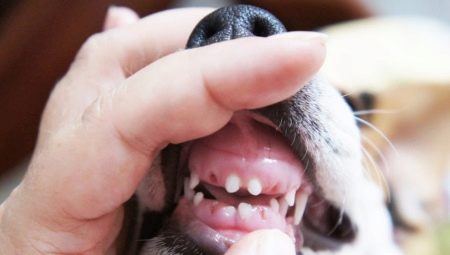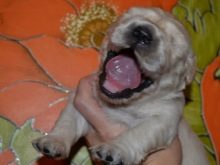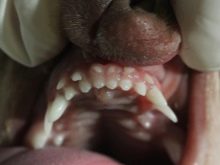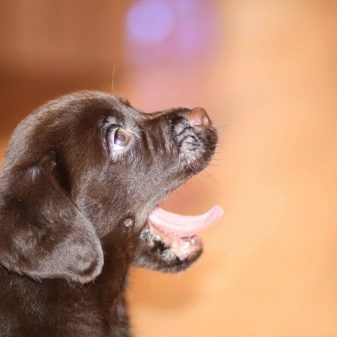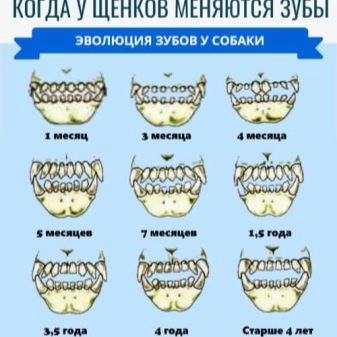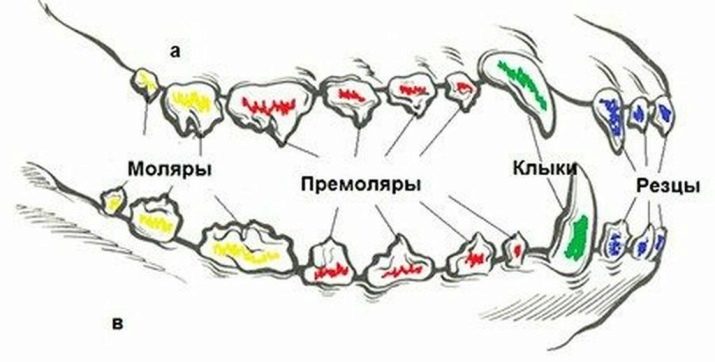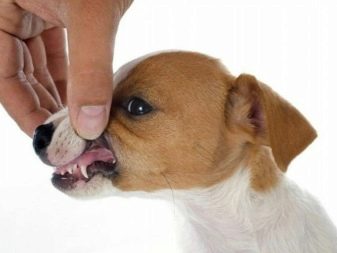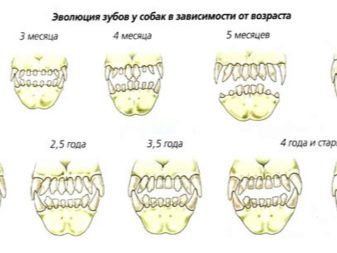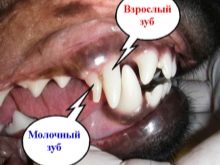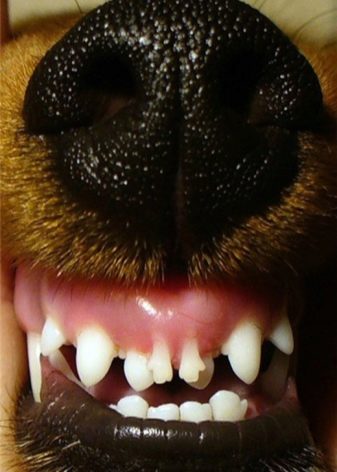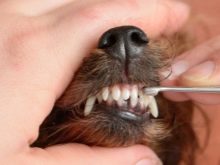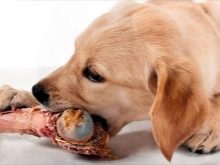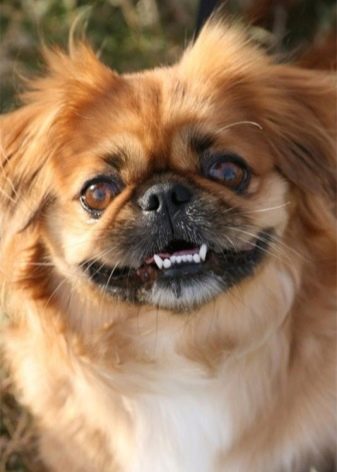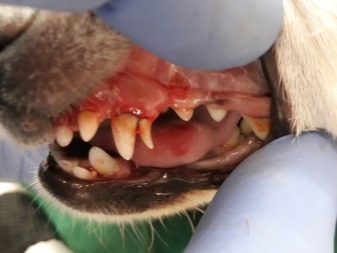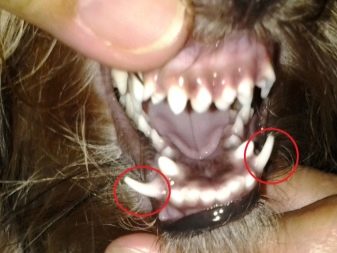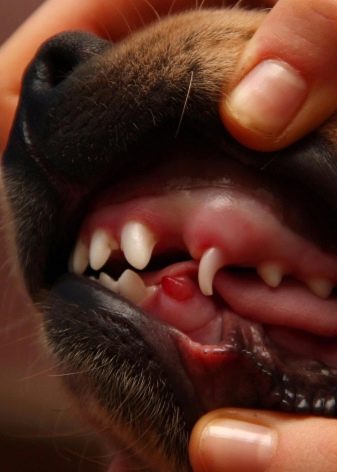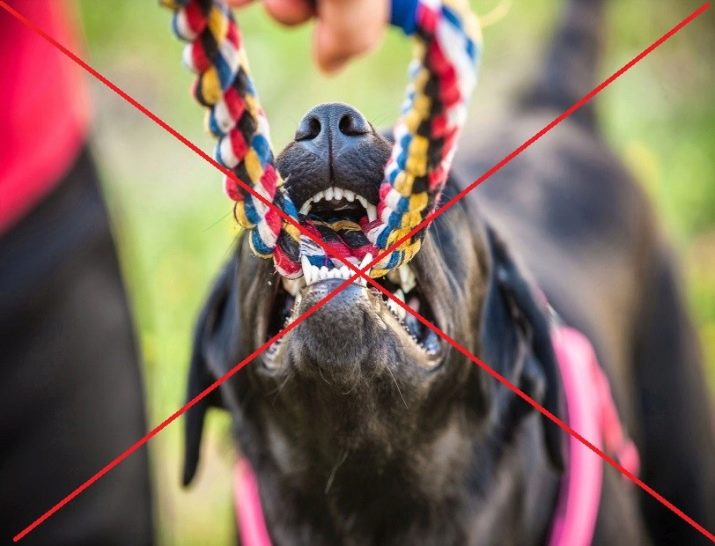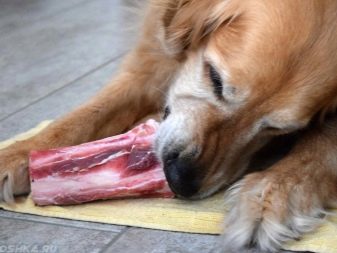With the help of teeth, a dog can get food for itself and, chewing, chop it, sort things out with its fellow tribesmen and protect itself if necessary. The female has the ability to move her puppies from one to another with her teeth, and even cleaning the hair from blood-sucking insects is impossible without the involvement of the front incisors of the dentition.
Puppies do not have teeth right after their birth, and at first babies grow baby teeth, and then they are replaced by permanent ones, in the amount of 42 pieces. This whole process takes place in the first year of a dog’s life. and ends at the age of 9 months. The change of teeth occurs in animals independently, but at the same time they sometimes need dental care. A person interferes with the natural course of events only if there is any anomaly in the development of the dentition or for the treatment of the sick teeth of his pet.
Time and dropout order
The pattern of appearance of the first dental units in dogs of most breeds is the same. Veterinarians note that small breeds of decorative dogs are about 1-2 months behind the formation of the dentition, whereas medium-sized or large breed of dogs are ahead of their development.
Physiologically, nature is laid so that the dog grows 32 milk dental units. They do not all appear at once, but successively, each in its own time.
- Fangs. They appear first in puppies, and this happens by the end of 2 or 3 weeks of life. Fangs appear first on the upper jaw - right and left, and then on the bottom. In total, the babies grow 4 dairy fangs.
- The incisors. In puppies, 6 incisors are cut at the upper and lower jaws. From above the incisors appear by the end of 3 weeks of puppy life, and from below they begin to grow at 4 weeks. The incisors are divided into hooks, middle and edge.
- Premolars A dog grows by 6 such dental units above and below, on each jaw. The growth of premolars occurs almost simultaneously with the incisors - at 3-4 weeks of the dog's life, and at first these teeth erupt in the upper jaw, and a week later the premolars already appear below.
- Permanent teeth. The function of the molars in puppies is performed by premolars, which, in the form of the structure, do not resemble what the permanent molars of an adult dog look like.
By the presence of cut teeth, you can easily determine the age of the dog in the first year of life in weeks. Puppy tooth formula has a peculiarity - on the upper and lower jaw the number of teeth is the same:
- 6 incisors;
- 2 fangs;
- 8 premolars
In babies, the first teeth are very thin and sharp, like needles. However, such a dentition is short-lived, since the dentin that makes up dental tissue has a softer structure, unlike permanent teeth. Milk dentition very quickly abraded and begins its change.
The puppy's baby teeth fall out in the following sequence.
- The dog's first incisors change, and this happens at the age of 3-4 months. First, hooks fall out, after them - middle incisors, and the last edge changes.
- Permanent molars appear on the maxillary arch beyond the premolars in 4-5 months.
- At the age of 6 to 8 months, dairy premolars begin to be replaced by permanent forms.
- At the age of 6-7 months, with the change of premolars, the change of canines also occurs.
- In the period from 7 to 9, and sometimes up to 10 months, the dog has permanent root premolars.
In total, the adult dog in the oral cavity should grow 42 permanent dental units with which the animal will live its entire life.
Dental formula of the upper jaw:
- 6 incisors;
- 2 fangs;
- 8 premolars;
- 4 molars.
Tooth formula of the lower jaw:
- 6 incisors;
- 2 fangs;
- 8 premolars;
- 6 molars.
The loss of the dairy dentition in a dog is due to the fact that, starting its growth, permanent dental forms, increasing in size, push and force out their dairy precursors. The first non-permanent dental units have no roots and are relatively easily detached from the dog's jaw.
How are new teeth erupting?
When a puppy grows teeth, this process occurs so that he feels a certain painful discomfort and his general well-being may deteriorate. The baby often has a high body temperature, but it does not last long and most often occurs when he sleeps. It’s easy to understand that a small pet started the period of changing the dentition - externally, the dog may become lethargic or, conversely, irritable and restless.
At such a time, the puppy's behavior changes - you will notice that your dog will feel an irresistible desire to gnaw something, and this is due to the fact that his gums constantly itch. To the puppy does not spoil your belongings and furniture, it is necessary to provide him with toys. After dairy units are replaced by a permanent dentition, the symptoms associated with this process disappear.
A swinging tooth, which is about to fall out, looks half detached from the gums and is often angled relative to other teeth. Sometimes the process of falling out is delayed and prevents the growth of a new tooth, then you can see that the old and the new, already cut teeth, are together. This neighborhood is abnormal and requires dental care, since permanent teeth in this case, the dog will grow with a shift, changing the shape of the bite.
It is important for the owner of the dog to track this moment in time and turn to the veterinarian, otherwise the dog is doomed to live with the wrong structure of the dentition. This will entail a violation of the process of chewing food, which means that the digestion process will also be disturbed over time.
At a time when a milk tooth row erupts in a puppy or is replaced, it is important for the owner not only to closely watch your pet, but also to contribute in every possible way to these processes. Veterinarians recommend a rocking tooth with a finger but in any case not to use with this great effort and not to pull it.
In such a period of life, the baby should be given not only to chew on toys, but also hard granules of dry food, bones and cartilage, hard vegetables., for example, such as pieces of fresh carrots - all this will help to shake the milk tooth and facilitate its loss.
In dogs of large and medium-sized breeds, the change of the dentition occurs relatively quickly and without pathologies, since the anatomical structure of their oral cavity provides enough space for the growth of dental units of various sizes. Decorative miniature breeds of dogs are most often faced with a delay in the loss of the milk series, as well as anomalous growth and development of permanent teeth.
This is explained by the fact that the oral cavity in such animals is not only small, but due to the nature of the breed it can be anatomically deformedFor example, like a French Bulldog or Pekingese. There is very little space for the growth of teeth on the maxillary arch, and if the tooth grows large in size, this inevitably leads to the deformation of the bite. It is very difficult for such dogs to examine the oral cavity for prophylactic purposes, therefore Often the process of changing the dentition is left to chance.
What to do if you do not fall out?
During the period of eruption of dairy and permanent dental units, the puppy needs regular observation and examination of its oral cavity.There are cases when a tooth erupting leads to inflammation of the gums. Then the festering wound needs to be cured, as the purulent process can go on to a healthy tooth. If there is no tooth in the dentition, it will displace all dental units located on the jaw. therefore All wounds and inflammations on the gums should be first washed with hydrogen peroxide, and then irrigated with warm extract prepared from medicinal chamomile.
If the time has come, but the baby tooth has not fallen out, it needs to be pulled out, and the doctor at the veterinary clinic can do it. Sometimes it happens that dogs have a close-up of both teeth - milky and permanent. Because of weak and soft dentin, the milk tooth starts to rot very quickly. And since a permanent tooth grows next to it, it is also involved in the process of decay, as a result of which the dog may lose a permanent dental unit.
Another common problem with the growth of teeth is the so-called hood, which is obtained from gum tissue. The tooth covered with such a hood cannot independently break out, and it either starts to rot inside the gum, or grows in the wrong position, interfering with the neighboring teeth.
In this case, the dog can only be a vet, which surgical instrument will open in the gum passage for the growth of the tooth. It is necessary to make this procedure in time, without waiting for the onset of inflammation in the gums and rotting of dental tissues.
Dental care
The owner of the puppy needs to conduct a regular inspection of the oral cavity with his pet and it should be done once a day. Some dog breeders mistakenly believe that it is not necessary to pay attention to the growth of the dairy dentition, as it will change anyway. Veterinarians have a different opinion and believe that how favorable the period of growth of the milk dentition is and how timely its replacement depends on what kind of dog will have permanent teeth.
During the period of the change and the growth of the dentition with the dog, you cannot play such games, where she will have to pull something with her teeth - this can lead to serious injuries to the gums and dental units.
After the appearance of permanent teeth, it is necessary to take care of them - the mouth of the mouth is treated with a special toothpaste and brush with a soft short nap. It is advisable that this pet hygiene procedure be done every day on a regular basis.
In order for the dog’s dentition and bite to be formed correctly, she needs to be given enough strain on her chewing muscles. The dog must have a large number of toys of varying degrees of hardness, and it must also be given such food where it could use its teeth — pieces of meat, cartilage, dry food pellets, and bones.
Dogs that eat soft foods such as pate, porridge, and meat soufflé are much more likely to suffer from caries and bite deformity. Moderately hard food contributes to the mechanical cleansing of the tooth surface and strengthens the dog's gums.
During the period of growth of the dentition, the dog must be provided with a sufficient amount of vitamins and minerals - only in this case, the tooth enamel will be formed strong and healthy. Preparations with calcium, fluorine and magnesium are introduced into the diet of the dog in the amounts that correspond to its body weight. In order to choose the right dosage of vitamin-mineral complex, it is best to consult a veterinarian for advice.
Permanent teeth should be taken care of by a pet - for this Do not play with him in such games that can spoil or break a dog's teeth. For example, it is not recommended to unscrew the stick that the dog holds in the mouth, you should not pull with force the rope or rag, in the fibers of which the tooth can easily get entangled, and you accidentally pull it out. A dog’s health and longevity largely depends on the good condition of its teeth, therefore the owner is required to help his four-legged friend to cope with this task.
For tips on changing teeth in dogs, see the video below.
